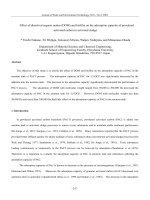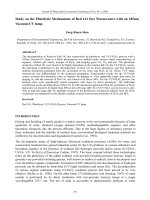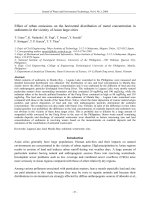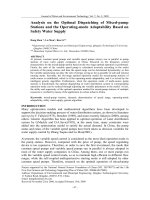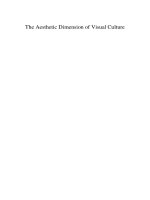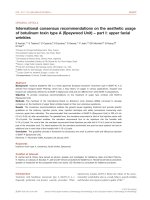International consensus recommendations on the aesthetic usage of botulinum toxin type A (Speywood Unit) – part I: upper facial wrinkles potx
Bạn đang xem bản rút gọn của tài liệu. Xem và tải ngay bản đầy đủ của tài liệu tại đây (386.49 KB, 7 trang )
ORIGINAL ARTICLE
International consensus recommendations on the aesthetic usage
of botulinum toxin type A (Speywood Unit) – part I: upper facial
wrinkles
B Ascher,
†,
* S Talarico,
‡
D Cassuto,
§
S Escobar,
–
D Hexsel,** P Jae
´
n,
††
GD Monheit,
‡‡
B Rzany,
§§
M Viel
––
†
Clinique de Chirurgie Esthe
´
tique Ie
´
na, Paris, France
‡
Universidade Federal de San Paulo, San Paulo, Brazil
§
University of Catania, Milan, Italy
–
Universidad de Buenos Aires, Buenos Aires, Argentina
**Pontificia Univeridade Catolica do Rio Grande do Sul, Porto Alegre, Brazil
††
Ramon y Cajal Public Hospital, Madrid, Spain
‡‡
Total Skin and Beauty Dermatology Center, Birmingham, AL, USA
§§
dEBM, Klinik fu
¨
r Dermatologie, Charite-Universita
¨
tsmedizin, Berlin, Germany
––
London Centre for Aesthetic Surgery, London, UK
*Correspondence: B Ascher. E-mail:
Abstract
Background Azzalure (Galderma SA) is a newly approved European botulinum neurotoxin type A (BoNT-A). It is
derived from Dysport (Ipsen Pharma), which has a long history of usages in various applications. Azzalure and
Dysport are collectively referred to as BoNT-A (Speywood Unit) and are different from other BoNT-A preparations.
Objective To provide consensus recommendations on the treatment of upper face wrinkles with BoNT-A
(Speywood Unit).
Methods The members of the International Board on Botulinum toxin Azzalure (IBBA) convened to develop
consensus on the treatment of upper facial wrinkles based on their own extensive experience.
Results The consensus recommendations address the general issues regarding treatment and provide specific
guidelines on the anatomy, injection points, dose, injection technique and safety precautions concerning each
common upper face indication. The recommended final concentration of BoNT-A (Speywood Unit) is 200 s.U ⁄ mL
(10 s.U ⁄ 0.05 mL) after reconstitution. For glabellar lines, the members recommend a total of five injection points with
10 s.U ⁄ point. For forehead wrinkles, the members recommend four to six injections into the frontalis with
5–10 s.U ⁄ point. For crow’s feet, the members recommend three injections per side with 5–10 s.U ⁄ point at the lateral
part of the orbicularis oculi. For lateral eyebrow lift, the members recommend one point at each eyebrow tail and an
additional one in each side of the frontalis with 5–10 s.U ⁄ point.
Conclusion This guideline provides a framework for physicians who wish to perform safe and efficacious injection
of BoNT-A (Speywood Unit).
Received: 17 November 2009; Accepted: 28 January 2010
Keywords
botulinum toxin type A, consensus, facial wrinkle, Speywood
Conflict of interest
B. Ascher and B. Rzany have served as advisor, speaker and investigator for Galderma, Ipsen and Merz Pharma.,
S. Talarico, D. Cassuto, S. Escobar, P. Jae
´
n and M. Viel are consultants for Galderma. D. Hexsel has served as consultant,
speaker or researcher for the companies which own toxins. GD. Monheit is a consultant for Galderma and Ipsen.
Introduction
Treatment with botulinum neurotoxin type A (BoNT-A) is a
frequently performed non-invasive cosmetic procedure. When
injected into muscles, BoNT-A blocks the release of the neuro-
transmitter acetylcholine and, as a result, helps to smooth wrinkles
and therefore may improve patient’s quality of life.
1,2
ª 2010 The Authors
JEADV 2010, 24, 1278–1284 Journal of the European Academy of Dermatology and Venereology ª 2010 European Academy of Dermatology and Venereology
DOI: 10.1111/j.1468-3083.2010.03631.x JEADV
Several commercial preparations of BoNT-A products are avail-
able for aesthetic usage. Among them, Azzalure (Galderma SA,
Lausanne, Switzerland) ⁄ Dysport (Ipsen Pharma, Boulogne-Billan-
court, France) and Vistabel ⁄ Botox (Allergan Inc., Irvine, CA,
USA) are the two most widely used products (Table 1). They are
produced from different strains of bacteria, purified and stabilised
using different methods and therefore have distinct chemical and
biological properties.
1
As the bioassays employed for activity mea-
surement are different for Azzalure ⁄ Dysport and Vistabel ⁄ Botox,
the units of these BoNT-A products are not interchangeable.
3,4
Az-
zalure and Dysport are quantified in Speywood Units (s.U), after
the name of the company (Speywood Biopharm Ltd., Mainden-
head, Berkshire, UK) who originally developed the product. They
are hereafter collectively referred to as BoNT-A (Speywood Unit).
Dysport is available in two different quantities, containing 500
and 300 s.U respectively. Dysport (500 s.U) has a 20-year history
of product consistency and safety in both therapeutic and aesthetic
usages.
5–8
Dysport (300 s.U) was approved in the U.S as abobotul-
inumtoxin A for aesthetic indication. Azzalure is derived from the
same bulk as Dysport, albeit in a different quantity (125 s.U).
It is specifically designed and approvals have been received recently
for aesthetic usages in 15 European countries.
Treatment in the glabellar region is the only labelled aesthetic
indication of BoNT-A products. Nevertheless, physicians routinely
inject BoNT-A to treat wrinkles in other facial and neck areas.
5,9–11
Although the procedure is generally effective and safe, a full
understanding of both BoNT-A properties and facial anatomy is
essential to ensure optimal treatment results. As there are only a
few clinical studies and regional guidelines available on the off-
label indications,
12–18
international consensus recommendations
would be helpful in providing a general guideline for effective
and safe injection of BoNT-A (Speywood Unit).
Methods of consensus development
The International Board on Botulinum toxin Azzalure (IBBA)
comprises nine dermatologists ⁄ plastic surgeons who have extensive
experience in the aesthetic usages of BoNT-A (Speywood Unit). In
addition, three board members (Ascher, Rzany and Monheit) were
leading investigators of several large-scale clinical studies on the
efficacy and safety of BoNT-A (Speywood Unit) in the treatment
of glabellar lines and crow’s feet. Board members convened to
develop the following consensus recommendations on various
upper face indications, based on their own experience during clini-
cal practice and based on the results of large clinical studies if they
were available. A strong consensus was defined as approval from at
least 90% of the board members (eight of nine members).
Consensus recommendations were developed to provide simple
guidelines for safe injection. Specifically, treatment safety is ensured
when the injector uses the recommended reconstitution volume,
injection points, dose and the correct injection technique (Table 2).
Highly risky injection points were not suggested; nor were indica-
tions requiring extensive experience. Strong consensus was
achieved for all four upper face indications. It is important to note
that the recommendations provided here refer to BoNT-A (Spey-
wood Unit), which includes Azzalure and Dysport and cannot be
applied to other formulations or preparations of BoNT-A.
Consensus recommendations
General preparation
Patient management. Patient education and counselling
are integral parts of the BoNT-A treatment. It is essential for the
patients to have a realistic expectation of the treatment outcome,
as their expectations determine the level of satisfaction after treat-
ment.
19
During counselling, the physicians should first analyse the
patient’s requests and be attentive to the difference between objec-
tive and subjective perceptions. They should also analyse the facial
anatomy, observing patients at rest and during movement, while
paying attention for any pre-existing asymmetry. The physicians
should then propose a coherent treatment plan based on the
patient’s request, facial anatomy and the status of skin ageing.
Next, the physicians should introduce BoNT-A, explaining its
mode of action, long history of usage and good record of safety.
The injection procedure needs to be explained to patients, as well
as the estimated onset of action and duration of effect. The physi-
cians should also explain potential adverse events and, if necessary,
the treatment to correct those undesired outcomes. Patients
should be clearly informed if they are about to receive injections
for an off-label indication, and all patients should read and sign an
informed consent form before treatment.
To assess the treatment outcome, it is recommended especially
in new patients to schedule a follow-up appointment about
3–6 weeks after the initial injection. Patients and physicians should
Table 1 Comparisons among various commercial botulinum neurotoxin type A (BoNT-A) preparations approved for aesthetic usage
Vistabel ⁄ Botox BoNT-A (Speywood Unit)
Azzalure Dysport (300 s.U) Dysport (500 s.U)
Company Allergan Inc. Galderma SA Medicis Pharmaceutical Co. Ipsen Pharma
Biological activity 50 or 100 U ⁄ vial 125 s.U ⁄ vial 300 s.U ⁄ vial 500 s.U ⁄ vial
Approved for aesthetic usages Yes Yes (in Europe) Yes (in US) Yes (in 5 countries around the world)
Stabilisation Vacuum dried Lyophilised
ª 2010 The Authors
JEADV 2010, 24, 1278–1284 Journal of the European Academy of Dermatology and Venereology ª 2010 European Academy of Dermatology and Venereology
Consensus on upper facial wrinkles treatment with BoNT-A 1279
compare the before and after treatment photos and ⁄ or videos and
estimate their level of satisfaction. If needed, patients can receive a
touch-up treatment with small doses during the appointment.
Reconstitution. Thevolumeofreconstitutioncanbeadapted
according to the quantity of product, physician’s preference and
patient’s needs, following the recommendations of health authori-
ties in different regions around the world. We recommend recon-
stituting the lyophilised powder of BoNT-A (Speywood Unit) in
preservative-free 0.9% sodium chloride solution to obtain a final
concentration of 200 s. U ⁄ mL (10 s. U ⁄ 0.05 mL). This was the
concentration used in the majority of international clinical studies
for the treatment of glabellar lines with BoNT-A (Speywood
Unit).
20–25
The recommended volume for reconstituting Azzalure
and Dysport (300 and 500 s. U) is summarised in Table 3. Recon-
stituting Azzalure and Dysport using the recommended volumes
would result in the same concentration for all preparations of
BoNT-A (Speywood Unit) and ensure treatment consistency.
Azzalure is designed for single-use and should be reconstituted
just before injection. BoNT-A (Speywood Unit) should be stored
in the refrigerator no longer than 4 h after reconstitution.
26,27
For
Dysport, it was reported that reconstituted vials can be stored at
4–8°C for up to 15 days without having microbiological contami-
nation or causing significant decrease in treatment efficacy.
28
Syringe and needle for injection. A1mLinsulin-type
syringe bearing the graduations of 10 s. U and 0.01 mL was
specially designed for reconstitution and injection of Azzalure. A
30G-13 mm needle is standard and is recommended for the injec-
tion of BoNT-A (Speywood Unit). The length of the needle is
divided into three parts (the first, middle and last third) and the
position of the needle is hereafter used as an indication of injec-
tion depth.
Glabellar lines
BoNT-A (Speywood Unit) is indicated for the treatment of mod-
erate-to-severe vertical lines in glabella. The efficacy and safety of
this treatment using BoNT-A (Speywood Unit) have been demon-
strated in several large-scale, double-blind, randomised and
placebo-controlled clinical studies in multiple centres around the
world.
20–25,29–31
Anatomy. The eyebrow depressor muscles consist of the proce-
rus, the corrugator, the depressor supercilii and the orbicularis
oculi. The procerus covers the nasal bones in which it inserts. The
corrugator supercilii is a narrow, strong muscle with deep medial
insertions on the glabellar periosteum and another more superfi-
cial lateral insertion in the skin above the medial portion of the
eyebrow. The orbicularis oculi muscle is a thin, broad muscle
Table 3 Recommended reconstitution volume for botulinum neurotoxin type A (BoNT-A) (Speywood Unit)
Final volume (mL) Final concentration Injection volume for
10 s.U 5 s.U 2 s.U
Azzalure (125 s.U) 0.63* 200 s.U ⁄ mL (10 s.U ⁄ 0.05 mL) 50 lL (0.05 mL) 25 lL (0.025 mL) 10 lL (0.01 mL)
Dysport (300 s.U) 1.5
Dysport (500 s.U) 2.5
*A specifically designed syringe adapted to the reconstitution volume is included with the product.
Table 2 Consensus recommendations on the injection points, dose and technique for common upper face indications of botulinum
neurotoxin type A (BoNT-A) (Speywood Unit)
Indication Dose per
injection
point (s.U)
No. injection
points
Total
dose (s.U)
Injection site Injection technique
Glabellar lines 10 5 50 0.5–1 cm from the upper
orbital rim and internal
to the mid-pupillary lines
Deep intramuscular and
perpendicular injections to the
last third of a 30G needle
Horizontal
forehead lines
5–10 4–6 20–60 Under the hairline, V-shape
in women and straight in
men, if applicable
Superficial intramuscular
and perpendicular
injections to the middle
third of an 30G needle
Crow’s feet 5–10 3 per side, total
6 points
30–60 External part of the
orbicularis oculi, 1–2 cm
from the external orbital rim
Superficial injections with
needle pointing away from
the eyes (20–30° angle to the
skin), to the first third of a 30G
needle
Lateral eyebrow lift 5–10 2 per side, total
4 points
20–40 One point at each eyebrow
tail, and the other at the
external part of the frontalis
Superficial intramuscular
and perpendicular
injections to the middle
third of a 30G needle
ª 2010 The Authors
JEADV 2010, 24, 1278–1284 Journal of the European Academy of Dermatology and Venereology ª 2010 European Academy of Dermatology and Venereology
1280 Ascher et al.
encircling the eye and adhering to the skin. The medial fibres of
the orbicularis oculi and the frontalis are intertwined with the
corrugator and may contribute to wrinkle formation in this
region. Contracting the corrugator and depressor supercilii
produces vertical lines between the eyebrows, while contracting
the procerus induces a horizontal line.
Injection point, dose and technique. For the treatment
of glabellar lines, a five-point injection is recommended, with one
point in the procerus and two points in each corrugator (Fig. 1).
All points should be 0.5–1 cm from the upper orbital rims and
internal to the mid-pupillary lines. The injection sites are the same
as those used in European studies.
22,29
Injection should be perpen-
dicular, intramuscular and deep, to the last third of a 30G needle.
Therecommendedtotaldoseis50s.U,equallydistributed
among the five injection points, with 10 s.U (0.05 mL) ⁄ point. The
treatment efficacy and duration of 50 s.U were similar to those of
75 s.U, while higher patient satisfaction was reported in the 50 s.U
group.
29,30
The recommended dose range for this indication is 30–
70s.U.Thefinaldosageforeachindividualdependsontheirmus-
cle structure, the wrinkle severity and patient’s preference of a
more natural or a more static look. Dose should also be adjusted
based on muscle mass, as bigger muscle requires a higher dose to
achieve a similar effect.
31
Safety concerns. Headache and injection site reactions are
the most frequently reported adverse events for this indication.
26,27
Eyelid ptosis, caused by involuntary involvement of the levator
palpebrae, can be prevented by adopting the recommended injec-
tion points and volume. The incidence of eyelid ptosis is usually
considered technique-dependent and was low in clinical studies
even after repeated treatments with BoNT-A (Speywood
Unit).
20–25,29–31
If ptosis occurs, it should be noted that the
symptom is temporary and usually subsides within a few weeks,
with no additional treatment required.
Horizontal forehead lines
Although this indication belongs to the off-label use of BoNT-A,
it is commonly practised, either alone or combined with the treat-
ment of the glabellar region. Injection of BoNT-A (Speywood
Unit) in the forehead is safe and effective in weakening horizontal
wrinkles.
5,32–34
Anatomy. The frontalis is a large, thin muscle closely attached
to the skin. Its medial fibres are joined at the glabellar region,
where they intersect with the procerus. Its central and lateral fibres
blend in with the corrugator supercilii and the inner part of the
orbicularis oculi. Contraction of the frontalis raises the eyebrows
and the upper eyelid, causing the formation of horizontal forehead
rhytides.
Injection point, dose and technique. For the treatment
of horizontal forehead lines, a total of four to six points are
recommended in the forehead below the hairline (Fig. 2). The
points should form a slightly curved V-shape in women, and
straight in men if applicable. For less experienced injectors, the
points should be sufficiently high on the forehead (about 4–5 cm
from the orbital rim) to avoid side effects such as brow ptosis. The
lateral points should be on the external orbital rim lines.
There is currently no dose-finding study performed on this
indication. The board members recommend a total dose range of
20–60 s.U, with 5–10 s.U ⁄ point. As the frontalis is a low-dose
reactive muscle, it is recommended to first start with a small dose
to avoid a ‘frozen’ look. Injection should be superficial, intramus-
cular and perpendicular to the skin, to the middle third of a 30G
needle.
Safety concern. To avoid brow ptosis, injection points should
be in the upper two-thirds of the forehead, sufficiently high above
the brow depressor. The minimal dose should be used first to
ensure treatment safety. If brow ptosis occurs, it should be noted
that the symptom is temporary and usually does not require
additional treatment.
(a)
(b)
Figure 1 Treatment of glabellar lines (a) Recommended injec-
tion points, the mid-pupillary lines and the upper orbital rim line
are illustrated (graph modified from de Maio and Rzany
9
).
(b) Photos of a patient at maximum frown before and 30 days
after the treatment with 50 s.U BoNT-A (Speywood Unit).
Courtesy of B. Ascher.
ª 2010 The Authors
JEADV 2010, 24, 1278–1284 Journal of the European Academy of Dermatology and Venereology ª 2010 European Academy of Dermatology and Venereology
Consensus on upper facial wrinkles treatment with BoNT-A 1281
If the external injection points are too close to the centre, move-
ment of the lateral frontalis can lead to wrinkle formation above
the lateral part of the eyebrows. This sign can be avoided by care-
fully assessing the position of the eyebrows before treatment, and
placing the lateral points on the external orbital rim lines.
Crow’s feet
Crow’s feet are dynamic lateral orbital wrinkles that appear when
smiling, and static wrinkles in this region caused by photoageing.
This is a common off-label indication and usually yields good
treatment results.
5,13,33,34
Treatment of crow’s feet with BoNT-A
(Speywood Unit) is both effective and safe, as demonstrated in a
multi-centre, double-blind, randomised and placebo-controlled
study.
13
Although effective in reducing hyperkinetic lines, BoNT-A
treatment is not suitable for treating the static wrinkles caused by
photoaging or sleeping habits.
Anatomy. The orbicularis oculi is usually divided into three
portions: the lacrimal portion at the medial side of the orbit,
whichisthesmallestandtheinnermost portion; the palpebral
portion that raises the eyelids and controls the involuntary action
of blinking; and the orbital portion or pars orbicularis, which
surrounds the orbit with concentric fibres, blends into the frontalis
and extends to the masseter. All three portions of the orbicularis
oculi need to function correctly to control the voluntary closing of
the eyelids.
Injection point, dose and technique. For the treatment
of crow’s feet, injection with three points per side (six points in
total) in the canthal region is recommended (Fig. 3). All points
should be at the external part of the orbicularis oculi and about
1–2cmfromtheexternalorbitalrim. The recommended injection
points are the same as those used in the clinical study.
13
Atotal
dose of 30–60 s.U is recommended, with 5–10 s.U ⁄ point and
15–30 s.U ⁄ side. Treatment of crow’s feet with 15, 30 or 45 s.U
BoNT-A (Speywood Unit) per side resulted in a slightly dose-
dependent but largely similar response rate.
13
The minimal injec-
tion dose should be adopted to avoid a ‘frozen look’ when smiling
and to ensure treatment safety. Injection should be lateral (20–30°
angle to the skin) and superficial to the first third of the needle.
Crow’s feet can be combined and treated together with lower
eyelid wrinkles if they are present. In this case, the same injection
points should be used with a slightly lower dose per point.
Safety concerns. Patient selection is crucial for this indi-
cation and the injector should avoid patients with dry eyes,
(a)
(b)
Figure 3 Treatment of crow’s feet (a) Recommended injection
points and the external orbital rim lines are illustrated (graph
modified from de Maio and Rzany
9
). (b) Photos of a patient
when smiling before and 30 days after the treatment with 30 s.U
BoNT-A (Speywood Unit) per side. Courtesy of D. Cassuto.
(a)
(b)
Figure 2 Treatment of horizontal forehead lines.
(a) Recommended injection points, the mid-pupillary lines and
the upper orbital rim line are illustrated (graph modified from de
Maio and Rzany
9
). (b) Photos of a patient at maximum
contraction before and 30 days after the treatment with 40 s.U
BoNT-A (Speywood Unit). Courtesy of B. Ascher.
ª 2010 The Authors
JEADV 2010, 24, 1278–1284 Journal of the European Academy of Dermatology and Venereology ª 2010 European Academy of Dermatology and Venereology
1282 Ascher et al.
prominent eye bags, scleral show or morning eyelid oedema. In
addition, patients need to have a positive snap test and preferably
good skin elasticity.
It is recommended that the injector positions himself or herself
opposite to the treatment side, so that the needle points away from
the patient’s eyes. The injector should use optimal lighting and
stretch the skin slightly to avoid injecting into blood vessels. To
avoid ecchymosis, injection should be very superficial and apply-
ing ice before and after injection may also be helpful. Deep injec-
tion or injection into the inferior region of the zygomaticus major
should be avoided, as it may lead to unwanted effects such as
drooping mouth corners.
The most frequently reported treatment-related adverse event
was mild periorbital haematoma. One 1 subject reported eyelid
ptosis among a total of 164 receiving BoNT-A (Speywood Unit)
of various doses.
13
Eyelid ptosis can be avoided by injecting super-
ficially and using the minimal injection dose and volume.
Lateral eyebrow lift
Eyebrows are usually positioned at the supraorbital rim or just
aboveit.Whenthelateralpartoftheeyebrowdrops,atiredor
sad look appears. BoNT-A treatment is the most commonly
adopted procedure to correct this sign. The injection procedure is
effective, safe and easy to perform compared to surgical
approaches. This is an off-label indication usually performed in
women only and in combination with other upper face treatments.
A full understanding of the muscles involved in determining brow
position is essential.
Anatomy. The frontalis serves as an elevator of the eyebrows to
maintain their normal position and to lift them to produce an
expression of surprise. The corrugator, the procerus and the orbic-
ularis oculi intervene with the frontalis and act as depressors of
the brow position. Contraction of the corrugator and the procerus
pull the internal and the medial part of the eyebrow downward;
whereas contraction of the pars orbicularis pulls the eyebrow tail
downward.
Injection point, dose and technique. A four-point
injection with two points per side is recommended (Fig. 4). One
injection point should be placed at each eyebrow tail into the pars
orbicularis. Once injected, BoNT-A blocks the depressor while the
frontalis functions normally to elevate the lateral part of the eye-
brow. Two additional injection points should be placed at the
external part of the frontalis, slightly more internal than the orbic-
ularis points. Injection in this part of the frontalis can further drop
the medial brow, reshape the entire eyebrow and accentuate the
lateral arch.
The recommended dose is 5–10 s.U ⁄ point and the total dose
range is 20–40 s.U. The final dose should be adjusted based on
expected treatment outcome, muscle mass and relative strength of
the orbicularis oculi and the frontalis. Injection should be superfi-
cial, intramuscular and perpendicular to the skin, to the middle
third of the needle.
Safety concerns . This treatment is usually effective and safe.
Eyelid and brow ptosis occur only rarely when the injection vol-
umeistoolargeorwhentheinjectionsitesaretooclosetothe
orbital rim. However, these adverse events can be prevented if the
recommended injection dose and techniques are adopted.
Summary
By developing the consensus recommendations, the panel mem-
bers, all of whom have extensive experience with BoNT-A (Spey-
wood Unit), provide a general guideline for the safe and effective
injection with this specific BoNT-A preparation. The consensus
recommendations address issues regarding the treatment with
BoNT-A (Speywood Unit) in general and each commonly
practised indication in the upper face. The general issues include
product reconstitution, choice of syringe and needle, as well as
patient management and selection. For each upper face indication,
anatomy is briefly reviewed and the recommended injection
points, dose and injection technique are provided. The consensus
recommendations help to ensure the maximal treatment safety
(a)
(b)
Figure 4 Lateral eyebrow lift. (a) Recommended injection
points, the mid-pupillary lines and the upper orbital rim line are
illustrated (graph modified from de Maio and Rzany
9
). (b) Photos
of a patient at rest before and 7 days after the eyebrow lift
treatment with 20 s.U BoNT-A (Speywood Unit). Courtesy of
M. Viel.
ª 2010 The Authors
JEADV 2010, 24, 1278–1284 Journal of the European Academy of Dermatology and Venereology ª 2010 European Academy of Dermatology and Venereology
Consensus on upper facial wrinkles treatment with BoNT-A 1283
and effectiveness, and serve as a starting point for further
adaptations among individuals in clinical practice.
Acknowledgement
The authors thank Dr Y. May Ma for editorial assistance.
References
1 Huang W, Foster JA, Rogachefsky AS. Pharmacology of botulinum
toxin. J Am Acad Dermatol 2000; 43: 249–259.
2 Sadick NS. The impact of cosmetic interventions on quality of life.
Dermatol Online J 2008; 14:2.
3 Pickett AM, Hambleton P. Dose standardisation of botulinum toxin.
Lancet 1994; 344: 474–475.
4 Karsai S, Raulin C. Current evidence on the unit equivalence of
different botulinum neurotoxin A formulations and recommendations
for clinical practice in dermatology. Dermatol Surg 2008; 34: 1–8.
5 Rzany B, Dill-Mu
¨
ller D, Grablowitz D, Heckmann M, Carid D.
Repeated botulinum toxin A injections for the treatment of lines in the
upper face: A retrospective study of 4103 treatments in 945 patients.
Dermatol Surg 2007; 33: S18–S25.
6 Markey AC. Dysport. Dermatol Clin 2004; 22: 213–219.
7 Van den Bergh P, Francart J, Mourin S, Kollmann P, Laterre EC.
Five-year experience in the treatment of focal movement disorders with
low-dose Dysport botulinum toxin. Muscle Nerve 1995; 18: 720–729.
8 Jitpimolmard S, Tiamkao S, Laopaiboon M. Long term results of
botulinum toxin type A (Dysport) in the treatment of hemifacial
spasm: a report of 175 cases. J Neurol Neurosurg Psychiatry 1998; 64:
751–757.
9 de Maio M, Rzany B. Botulinum Toxin in Aesthetic Medicine. Springer,
Heidelberg, 2007.
10 Ascher B, Landau M, Rossi B. Injection treatments in cosmetic surgery.
Informa Healthcare, London. Editor 2008
11 Carruthers A, Carruthers J. A single-center, dose-comparison, pilot
study of botulinum neurotoxin A in female patients with upper facial
rhytides: safety and efficacy. J Am Acad Dermatol 2009; 60: 972–979.
12 Lowe NJ, Ascher B, Heckmann M, Kumar C, Fraczek S, Eadie N.
Double-blind, randomized, placebo-controlled, dose-response study of
the safety and efficacy of botulinum toxin type A in subjects with
crow’s feet. Dermatol Surg 2005; 31: 257–262.
13 Ascher B, Rzany BJ, Grover R. Efficacy and safety of botulinum toxin
type A in the treatment of lateral crow’s feet: double-blind, placebo-
controlled, dose-ranging study. Dermatol Surg 2009; 35: 1478–1486.
14 Flynn TC, Carruthers JA, Carruthers JA, Clark RE II. Botulinum A
toxin (BOTOX) in the lower eyelid:dose-finding study. Dermatol Surg
2003; 29: 943–950.
15 Rzany B, Fratila A, Heckmann M. Expertentrffen zur Anwendung von
Botulinumtoxin A in der A
¨
sthetischen Dermatologie. Kosmetische
Medizin 2005; 3: 1–8.
16 Sommer B, Bergfeld D, Sattler G. Consensus recommendations on the
use of botulinum toxin type A in aesthetic medicine. J Dtsch Dermatol
Ges 2007; 5(Suppl. 1): S1–S29.
17 Carruthers J, Fagien S, Matarasso SL. Consensus recommendations on
the use of botulinum toxin type A in facial aesthetics. Plast Reconstr
Surg 2004; 114(Suppl. 1): S1–S22.
18 Carruthers J, Glogau RG, Blitzer A. Advances in facial rejuvenation:
botulinum toxin type A, hyaluronic acid dermal fillers, and
combination therapies – consensus recommendations. Plast Reconstr
Surg 2008; 121: S5–S30.
19 Lewis CM, Lavell S, Simpson MF. Patient selection and patient
satisfaction. Clin Plast Surg 1983; 10: 321–332.
20 Ascher B, Zakine B, Kestemont P et al. Botulinum toxin A in the
treatment of glabellar lines: scheduling the next injection. Aesthet
Surg J 2005; 25: 365–375.
21 Rzany B, Ascher B, Fratila A, Monheit G, Talarico S, Sterry W. Efficacy
and safety of 3- and 5-injection patterns (30 and 50 U) of botulinum
toxin A (Dysport) for the treatment of wrinkles in the glabella and the
central forehead region. Arch Dermatol 2006; 142: 320–326.
22 Moy R, Maas C, Monheit G, Huber MB. Long-term safety and efficacy
of a new botulinum toxin type A in treating glabellar lines. Arch Facial
Plast Surg 2009; 11: 77–83.
23 Rubin MG, Dover J, Glogau RG, Goldberg DJ, Goldman MP,
Schlessinger J. The efficacy and safety of a new U.S. Botulinum toxin
type A in the re-treatment of glabellar lines following open-label
treatment. J Drugs Dermatol 2009; 8: 439–444.
24 Brandt F, Swanson N, Baumann L, Huber B. Randomized, placebo-
controlled study of a new botulinum toxin type A for treatment of
glabellar lines: efficacy and safety. Dermatol Surg 2009; 35: 1893–1901.
25 Monheit GD, Cohen JL. Long-term safety of repeated administrations
of a new formulation of botulinum toxin type A in the treatment of
glabellar lines: interim analysis from an open-label extension study.
J Am Acad Dermatol 2009; 61: 421–425.
26 Galderma SA. Azzalure, Summary of Product Characteristic (SmPC).
[WWW document] 2008. URL />21985 (last accessed: 4 March 2010).
27 Ipsen Ltd. Dysport, Summary of Product Characteristics (SmPC).
[WWW document] 2007 URL />870/SPC/Dysport/ (last accessed: 4 March 2010).
28 Hexsel D, Rutowitsch MS, de Castro LC, do Prado DZ, Lima MM.
Blind multicenter study of the efficacy and safety of injections of a
commercial preparation of Botulinum toxin Type A reconstituted up to
15 days before injection. Dermatol Surg 2009; 35: 933–939.
29 Ascher B, Zakine B, Kestemont P, Baspeyras M, Bougara A, Santini J.
A multicenter, randomized, double-blind, placebo-controlled study of
efficacy and safety of 3 doses of botulinum toxin A in the treatment of
glabellar lines. J Am Acad Dermatol 2004; 51: 223–233.
30 Monheit G, Carruthers A, Brandt F, Rand R. A randomized, double-
blind, placebo-controlled study of botulinum toxin type A for the
treatment of glabellar lines: determination of optimal dose. Dermatol
Surg 2007; 33: S51–S59.
31 Kane MA, Rohrich RJ, Narins RS, Monheit GD, Huber MB. Evaluation
of variable-dose treatment with a new U.S. botulinum toxin type A
(Dysport) for correction of moderate to severe glabellar lines: results
from a phase 3, randomized, double-blind, placebo-controlled study.
Plast Reconstr Surg 2009; 124: 1619–1629.
32 Karsai S, Adrian R, Hammes S, Thimm J, Raulin C. A randomized
double-blind study of the effect of Botox and Dysport ⁄ Reloxin on
forehead wrinkles and electromyographic activity. Arch Dermatol 2007;
143: 1447–1449.
33 Farahvash MR, Arad S. Clostridium botulinum type A toxin for the
treatment of upper face animation lines: an Iranian experience.
J Cosmet Dermatol 2007; 6: 152–158.
34 Dewandre L, Voloshchenko I, Trembach A. Etude comparative pilote
de l’efficacite
´
et de la dure
´
e d’activite
´
de Dysport vs Botox dans les
indications esthe
´
tiques classiques (front, glabelle, patte d’oie). JMe
´
d
Esth et Chir Derm 2003; 118: 101–107.
ª 2010 The Authors
JEADV 2010, 24, 1278–1284 Journal of the European Academy of Dermatology and Venereology ª 2010 European Academy of Dermatology and Venereology
1284 Ascher et al.

